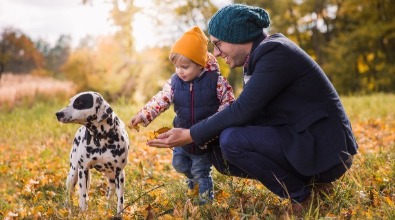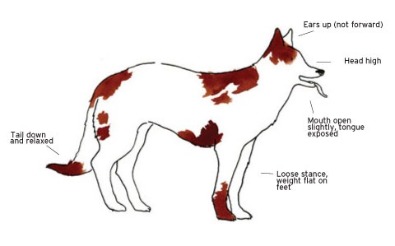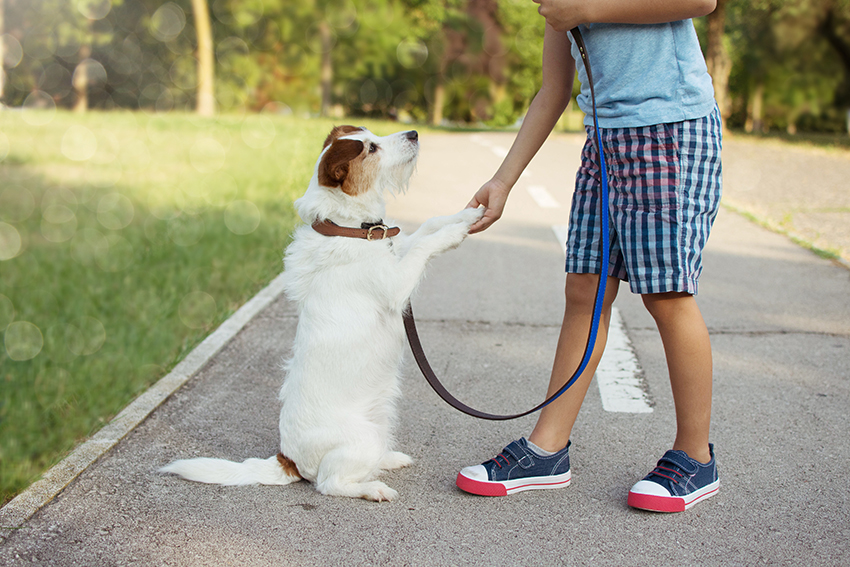In this post:
- Importance of teaching your child dog body language
- What does a happy dog look like?
- What does a scared dog look like?
- What does an angry dog look like?
If you’re bringing a new dog into a house with children, you need to make sure that your child can recognize a dog’s body language. Just as you recognize when your child is upset, angry, or happy, you need for your child to recognize those emotions in canine form. This can go a long way in preventing a bad situation that could leave someone hurt or could shed a negative light on your dog. Remember that a dog bite – even when the dog was protecting itself – can result in the dog being put down, so make sure that the situation is safe for both your children and your dog(s).
Importance of teaching your child dog body language
Texas Veterinary Medical Association (TVMA) would like to emphasize how education and awareness are the keys to preventing many, if not most, dog bites. An estimated 4.5 million dog bites are reported each year, according to the Centers for Disease Control and Prevention, and 20 percent of these incidents require emergency medical care. At least half of the victims who require medical attention are children. Pet owners can take preventative measures to decrease the number of dog bites, from teaching children how to avoid dog bites to properly training and socializing pets.

You want your children to be safe around dogs and learning dog body language is an important step. Teaching your child to recognize what a happy dog looks like can help them know which dogs are approachable and which ones to avoid. Point out dogs on walks and watch videos with your child about dog behavior. Always supervise your child when interacting with dogs.
Here are some resources for parents to learn more about dog body language:
What does a happy dog look like?

A happy dog will have a happy face and have their ears perked up and a wagging tail. If the tail is fast and relaxed, then it is happy. A happy dog has a tongue out and is jumping around. Give a happy dog lots of love.
- Mouth slightly open, tongue relaxed and lolling to one side.
- Play bow – this signal invites play and tells others that whatever action comes next is still just play.
- Turning over, inviting belly rub – showing trust and enjoying social contact.
- Relaxed facial expression.
- Squinty or blinking eyes.
- Tail wagging fast, either side to side or in a round motion like a helicopter.
- Wiggling backside.
What does a scared dog look like?
Scared dogs can easily bite a child if they do not get the space they need. Make sure your child knows what a scared dog looks like. It is your job to help your child stay safe and help reduce the dog bites that happen to children. You should never leave a child alone unsupervised with a dog, as accidents can happen.
Help children understand to have the dog come to them and not go into the scared dog’s safe place. Encourage the child to get down on the dog’s level and throw some treats to them.
Common signs that the dog is not comfortable in the situation from Victoria Stillwell:
- Yawning can be a sign that a dog is tired, but it also signals stress
- Lip licking or tongue flicking. Dogs lick their lips when nervous
- Body freezing – the dog freezes until the threat goes away or he decides to use fight or flight
- ‘Whale Eye’ – the dog turns his head away but keeps looking at the perceived threat, showing the whites of his eyes
- Head turn – the dog will turn his head away from a fear source as a gesture of appeasement
- Furrowed brow, curved eyebrows – caused by facial tension
- Tense jaw – the mouth is closed, and the dog is preparing for action
- Hugging – a dog will gain comfort by holding onto his owner
- Low tail carriage – indicates discomfort and uncertainty
- Curved tongue – the tongue is curved at the edges from tension
- Raspy, dry-sounding panting – nervousness reduces saliva production
- Twitching whiskers – caused by facial tension
- Shaking – caused by adrenaline release
- Drooling – stress can also cause excessive salivation
- Lack of focus – an anxious dog finds learning difficult
- Sweaty paws – dogs sweat through their foot pads
- Piloerection – the hair on a dog’s neck and spine stands on end (like human goosebumps), making the dog appear bigger while releasing odor from the glands contained in the dog’s hair follicles
What does an angry dog look like?
Children are the number one victim of dog bites! When a dog thinks that he or she needs to defend themselves from a perceived threat, he will display certain behaviors that are meant to tell you or your child to back off. If your child continues to be around the dog, the dog can and probably will bite.
Please keep your kids and dogs safe by supervising at all times and helping your child understand how to be around dogs and help your dog be better around your child. Play some games with them both and encourage your child to participate in training with your dog.
How to Tell if a Dog is Being Aggressive:
- Body leaning forward
- Tense mouth
- Lips pushed forward and vibrating as the dog growls
- Air snapping – the dog snaps in the air to warn something to back away
- Snapping with skin contact – also a warning to back away
- Fast nip – an immediate bite and release with bruising or slight wound, telling a threat to back off
- Deeper bite – a dog that bites with more intensity is intending to harm
- Bite and hold – intent to harm
- Bite, hold, and shake – intent to harm and the potential to kill. Some dogs will bite, hold, shake, and disembowel stuffed toys, simulating the killing of prey; while this is prevalent among dogs with high prey drive, even dogs with low drive can indulge in the behavior of this type. If your dog likes to disembowel stuffed toys, this doesn’t mean he wants to do the same with people or other animals. Sadie loves to disembowel toys, but she is incredibly gentle with people, especially children.
- Wagging tail – again, a wagging tail does not always mean a happy dog. Watch for very slow side-to-side sweeps of the tail
- Hard, staring eyes
Final thoughts:
If you’re bringing a dog into a house with kids, then it’s your responsibility to ensure that there are no accidents. Even with training, you should never leave your child alone with your dog. This will prevent accidents, misunderstandings, and bad situations nearly 100% of the time. Remember that you’re bringing a dog into your home – that means that you’ve made a promise to protect that dog in addition to protecting your children. This is a big responsibility and you need to take it seriously in order to ensure a safe and happy environment for everyone involved.
If you take care to be responsible, then you and your children are in for a long and rewarding relationship with your dog that is rewarding for everyone. Trust me, going the extra mile is WORTH IT!





